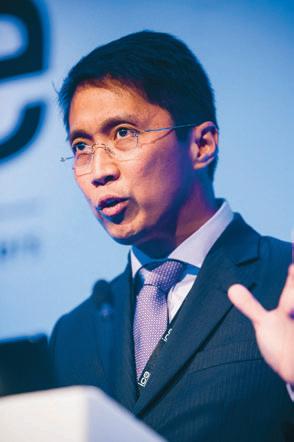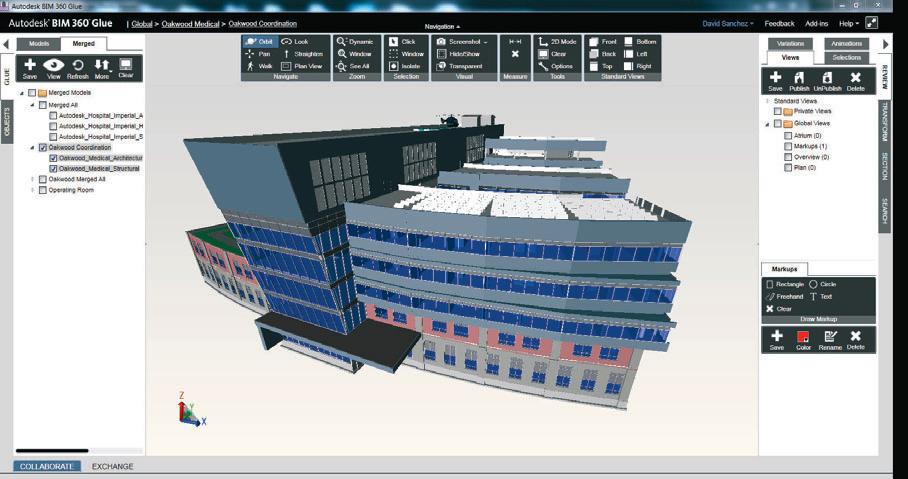
7 minute read
ICE BIM 2012
3


1 Representatives from RIBA, BIFM, ICE, CIC, and AGI participated in a panel discussion to explore how they can work together more collaboratively 2 Aberlardo M. Tolentino Jr, president of Aidea Philippines, shared his experiences of managing ‘mindset change’ when moving from 2D to BIM 3 Paul Morrell, chief construction advisor, delivered an update on the government’s construction strategy
ICE BIM 2012
In October the Institution of Civil Engineers (ICE) held its second annual BIM conference. The mix of presentations, panel discussions and roundtables promoted some healthy debate into the future of Building Information Modelling for infrastructure. Greg Corke reports.
An impressive 69% of delegates at who use the facilities. “Focus on the benefits ICE BIM 2012 were using that BIM can give us in the ‘operate and Building Information Modelling maintain’ world and make sure design and (BIM), one of the many live polls construction are passing those things taken throughout the day revealed. But what through,” he said, after explaining how two exactly is BIM and how does it relate to civil Crossrails are being built, one that contains engineering? One delegate asked is it time for the physical assets and one that contains the a new name, referring to the huge benefits virtual assets. BIM offers for operation and maintenance in The importance of BIM data was a maininfrastructure projects. Asset Information stay. There was plenty of emphasis on the Management (AIM) was offered up as a value of only ‘dropping’ data that is absomore appropriate three-letter acronym. lutely essential to each stage of a project. Too
Paul Morrell, the chief construction advi- much data can become a burden. sor to the government, dismissed this idea. Stephen Hamil, Head of BIM at NBS, gave He believes the ‘building’ in BIM has now a compelling talk on the information that become less important. “Fortunately, it matters in government projects. Mr Hamil, works as an acronym,” he explained. “Not who is heavily involved in developing the many people call it Building Information National BIM Library, talked about the need Modelling any more. BIM means many for standardisation and making well-structhings to many different people.” tured data accessible to all using a common
Mr Morrell added that two years ago he language. See page 10 for more of his was told that BIM could not apply to a linear thoughts on the Importance of ‘I’ in BIM. asset. “So [with BIM now widely acknowl- Mr Morrell confirmed this need for stanedged in civil engineering] that’s how far dardisation, not just in terms of how inforwe’ve come in two years,” he said. mation is presented, but in reducing the
As a conference, ICE BIM 2012 presented number of specifications. He referenced an a very broad view of BIM. There was argu- asphalt yard in the Midlands that has to ably as much focus on building and architecture as there was on highways, rail and infrastructure. Jamie Johnston of the BIM Task ‘‘ BIM is not just a construction Group, the body that is helping deliver the objectives of the UK delivery tool. Its real value Government Construction Strategy, comes from seamless handover stressed the importance of taking a co-ordinated approach. “One of the from construction to operation most powerful things we’ve achieved in the last year is to get all the institutions — RIBA, CIBse, BSRIA — in make 270 different specifications because ’’ the same room to start trying to co-ordinate nobody accepts anyone else’s spec. Stop retheir plans of work,” he said, explaining that inventing the wheel, he said. the institutions are now uniting under com- There was plenty of talk about COBie mon project stages, where 0 is a strategic (Construction Operations Building stage and 7 is operation and end of life. Information Exchange), the government
Representatives from RIBA, BIFM, ICE, mandated BIM data schema that is to be CIC, and AGI also participated in a panel used to help manage the design, construcdiscussion exploring how they can work tion and operation of public buildings. together more collaboratively. Phil Jackson, However, it is clear there is still a big chalchair of the ICE information panel, empha- lenge in terms of education. Indeed, a live sised the value of bringing the asset manag- poll revealed that 29% of delegates did not er in at the start of the process. Indeed, the know what COBie was. benefits of defining the data required for Mr Morrell acknowledged that there was operations and maintenance early on in a still work to do. “[COBie] is a hard thing to project was a recurring theme. come to love,” he said. “We have to find some
Terry Stocks, head of project delivery unit way of softening its image so people can be for the Ministry of Justice, said that in client attached to COBie and understand it.” organisations like the MoJ, the asset manage- Terry Stocks explained the urgent need ment function needs to be fully bought into for good COBie validation and interrogation and involved in the BIM process from day tools. Often, the vast amount of data in the one. “BIM is not just a construction delivery COBie file makes it almost unusable, he said. tool. Its real value comes from seamless han- Jamie Johnston offered a more positive dover from construction to operation.” outlook for working with COBie data. “We’re
Malcolm Taylor, head of technical infor- already seeing a market emerging for apps mation, Crossrail, confirmed that the bene- that are taking COBie and doing lots of clevfits of BIM that are created in design and in er things with it,” he said. “So it’s come to a construction are best received by the people point where COBie becomes the invisible pocket — the data transfer mechanism — that no one really looks under the bonnet. You’re simply looking at the outputs that you need whether it be on your iPad or your iPhone, or whatever it is.”
The event wasn’t just about technology. Aberlardo M. Tolentino Jr, president of Aidea Philippines, shared his experiences of managing ‘mindset change’, which he described as the biggest challenge his architectural practice encountered when implementing BIM.
Mr Tolentino explained how, in the move to a BIM workflow, the biggest opposition came from his 2D CAD experts, worried that they would lose their expertise. So his firm decided to take the bold move to undergo an immediate transition to BIM, not a phased approach taken by most firms.
On day one Aidea completely removed 2D CAD software from every computer and started using only BIM. “There was a reason we did it that way,” he said. “If we don’t give people the chance to go back to the old system then there’s a bigger chance we will succeed in transitioning. It will be painful for a while, but the pain can be managed.” Aidea’s pain did not last long. After three months, the company was as efficient as with 2D. After six months it was starting to realise the benefits, and continued to gain more efficiency by assigning studio BIM managers, creating a BIM manual and carrying out BIM audits at different stages of a project to ensure quality. The firm has now become one of the most successful BIM-centric practices in the world, recently picking up the OpenBIM award at Build London Live 2012 in May.
ICE BIM 2012 was high on delegate participation. One of the most interactive BIM conferences in the construction calendar it offered much more than back-to-back presentations. Panel discussions, roundtables, and Q and As punctuated the proceedings, creating a sense of community among the 300 delegates and promoting lively debate.
Overall, it was acknowledged that the BIM Task Group needed to do more to help the civil engineering industry in particular. Delegates called for more advice on software, civils-based reference pilot projects, and availability of standard civils objects.
However it was also suggested that firms needed to take a more active role in helping shape future BIM strategies. Participation through working groups such as BIM4Rail, BIM4Retail was one way to increase engagement and share knowledge and experience with peers. A BIM for SME group was also in progress to help those that thought BIM was just for the major firms.
Through increased engagement from all sides, we should see the number of delegates using BIM rise next year. ■ ice-bim.com






